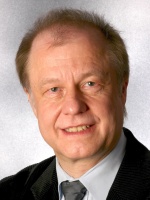
Gottfried Wilhelm Leibniz Universität Hannover
Institut für Mensch-Maschine-Kommunikation
FG Graphische Datenverarbeitung
Welfengarten 1 • 30167 Hannover
Vita
Dr. Wolter was Head of the Computer Science Institute at the University of Hannover from 1996 till 2000. He has been chair of Computer Graphics, Geometric Modeling and Computational Geometry at the University of Hannover since the winter term of 94/95. In this capacity he is a full professor in the department of computer science and directs the Division of Computer Graphics and Geometric Modeling.
Before taking up his post in Hannover, Dr. Wolter held faculty positions at the University of Hamburg (in 94), MIT (89-93) and Purdue University in the USA (87-89).
Prior to this he developed industrial expertise as a software and development engineer with AEG in Germany (86-87) developing software systems for adaptive thickness control of hot strip steel mills and digital speed control systems for electrical motors.
Dr. Wolter obtained his Ph. D. in l985 from the department of mathematics at the Technical University of Berlin, Germany, in the area of global differential geometry (Riemannian Manifolds). In 1980 he graduated in mathematics and theoretical physics from the Free University of Berlin. He has been a research fellow at the TU Berlin, a visiting scholar at the University of Illinois and at the TU Darmstadt, and a visiting professor at the University and the Scuola Normale of Pisa (Italy) and MIT.
His teaching experience encompasses a wide variety of diverse areas in mathematics and computer science. His research interests include geometric modeling and computer graphics and recently in the context of specific Virtual Reality applications research on some aspects of man/machine communication including research on haptic perception and recognizing phonem articulation by human lip motion.
In 1997 he started to supervise several thesis projects creating new virtual reality and geometric modeling tools to be applied in car design at the Volkswagen company. These projects include research on physical modeling, force feed back, haptic perception and parts of human modeling.
At MIT Dr. Wolter codeveloped the geometric modeling system Praxiteles for the US Navy from 1989 to 1993 and published various papers that broke new ground applying concepts from differential geometry and topology on problems and design of new methods used in geometric modeling and CAD systems. In this context he has worked on a variety of different problems including surface blends, higher order surface contact, surface intersections, degenerate surface patches, distance computations, curve approximations and global shape analysis, reconstruction and design employing the medial axis. At MIT this work included the development of a system comparing the shape of manufactured objects with the free form design specification. This system is used by the US Navy for manufacturing quality control of submarine propellers.
At present Dr. Wolter is extending this work (in the context of an external Ph.D. project) to develop automated quality control systems for the car industry to be applied at the VW-AG. He is a founding member of the interdisciplinary "Center of Excellence for Computational Engineering Sciences" (1999) (recommended by a DFG committee) related to new study programs with different degrees (bachelor, master, Ph.D.) Dr. Wolter is also a founding member of the Graduate College "Interaction Modeling, Computation Methods and Software Concepts for Scientific - Technological Problems" started in 2000 at the University of Hannover. This Graduate College is supported by the German Research Foundation (DFG) and complements the activities in the aforementioned Center of Excellence.
In 1997 Dr. Wolter pioneered the first computational methods for geodesic Voronoi Diagrams on Free Form Surfaces. He recently started projects reconstructing the boundary representation of caves (considered as longterm radioactive waste disposal sites) using position points on the cave boundary obtained by optical laser measurements. This project includes also the development of specific automated 3-D-meshing tools supporting the solution of differential equations relevant to assess longterm geophysical (chemical) processes being important to decide longterm safety of the disposal site.
Prof. Wolter has given many seminars at the Mathematical Research Institute Oberwolfach (Germany), at the Computer Science Research Center Dagstuhl Castle (Germany) and at many places in Europe, Asia and the US including Harvard, Yale, Stanford, Brown Univ., Columbia Univ., Carnegie Mellon Univ., MIT and the IBM T. J. Watson Research Center. In November 1996 Dr. Wolter gave keynote lectures on the first Unified Chinese Computer Graphics Congress China Graph '96 and in February 99 in the Czech Republic on the International Conference in Central Europe on Computer Graphics and Scientific Visualization.
Dr. Wolter has successfully applied to the US NSF, the DFG (German Research Foundation) and other agencies for various grants. He is on the editorial boards of The Visual Computer and the International Journal of Shape Modeling and guest editor of those journals as well as of the journal Graphical Models and Image Processing and the Journal of Visualization and Computer Animation. He was responsible for the organization of the Computer Graphics International Congress CGI'98 which was with respect to the number of presented contributions (about 120) the largest scientific computer graphics congress organized in Germany until now. Dr. Wolter is a member of GI and one of the two German members of IFIP WG 5.10 in Computer Graphics and Virtual Worlds.
Publications
A list of selected publications of
F.-E. Wolter et al. can be found at
vollstaendige-publikationsliste



